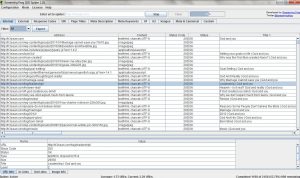https://www.screamingfrog.co.uk/seo-spider/
Author: Bitstop Network Services
BNS provides live streaming for townhall debates
BNS was engaged by Manila Bulletin to design and deploy a live video stream of the townhall presidential debates. The aim is to provide as wide a coverage as possible to the historic event.
The live stream needed to provide 720P HD video signal to an estimated 40,000 simultaneous viewers. BNS deployed rtmp encoder and rtmp relay servers to achieve this goal.
Presidential Debate Part I https://www.facebook.com/manilabulletin/videos/10154341562722985/
Presidential Debate Part II https://www.facebook.com/manilabulletin/videos/10154341600722985/
Presidential Debate Part III https://www.facebook.com/manilabulletin/videos/10154341694387985/
Presidential Debate Part IV https://www.facebook.com/manilabulletin/videos/10154341754527985/
Presidential Debate Part V https://www.facebook.com/manilabulletin/videos/10154341803362985/
Presidential Debate Part VI https://www.facebook.com/manilabulletin/videos/10154341844752985/
Presidential Debate Part VII https://www.facebook.com/manilabulletin/videos/10154341927297985/
Presidential Debate Part VIII https://www.facebook.com/manilabulletin/videos/10154342000032985/
BNS Deploys Gigabit speed wifi network for Pres Debates
BNS was tapped by Manila Bulletin, the co organizer of the 3rd Presidential debate that was held at the PHINMA University of Pangasinan.
BNS deployed an open source firewall (Pfsense) with web accelerator (transparent cacheing proxy) to further enhance the speed of the dual links. The two links were made up of the 1gbps fiber link deployed by PLDT and the 500mbps Radio link to BNS via Ligowave antenna systems.
Speedtest.net showed speed around 860mbps when measured by MDICT officials.
http://newsinfo.inquirer.net/781475/online-group-analyzes-presidential-debate
Scary Data – Trends in Malware, Phishing, Site Cleaning and Bad Networks
Almost Half a Million Malware Sites
The number of Malware sites continues to grow, hitting a new peak of 489,801 in October of 2015. That is up over 160% from the same time the previous year. As we have discussed before, a website that is infected with malware can install malicious software on your computer if you visit it. Attackers use the software to steal sensitive information from you such as credit card information and social security numbers.
As an internet user, the growth in malware sites means that the odds of you accidentally visiting one and becoming infected continue to increase. Google and the other search engines do a decent job of flagging them, but they can’t catch all of them in time to provide complete protection.
As a website owner, it means that attackers are having more success than ever compromising websites. It goes without saying that we think you should take website security seriously.
150% Growth in Phishing Sites in 7 Months
According to Google there are now 293,747 phishing sites on the internet, up from 113,132 in July of last year. This represents growth of over 150% in a mere seven months. A phishing site attempts to trick you into thinking it is legitimate, like your online bank or an online retailer. They then lure you into providing login credentials or other sensitive information. In the Introduction to WordPress Security article in our Learning Center we talk about how attackers are even using phishing tactics to steal WordPress credentials.
It’s taking webmasters up to 90 days to respond
Google measures how long it takes for webmasters to take action after they have received notice that their site has been compromised. Over the last year, the fastest average webmaster response time reported was 61 days, and for much of the year it was 90 or worse.
Which neighborhoods to avoid on the internet
Google provides very interesting data about the rate of infection for differentAutonomous Systems on the internet. An Autonomous System is a network level designation that represents a pool of IP addresses that are under the control of one or more networks on behalf of a single entity. You can think of it roughly as the group of IP addresses that have been assigned to an ISP. The data is very interesting, and aligns with what we learned in the analysis of brute force attacks we did a few weeks ago.
The thing that jumps out the most to us is the incredibly high penetration of infection on some Autonomous Systems. With infection rates as high 49%, there are areas of the internet that we would strongly encourage you to avoid. If you want to check out what Autonomous System your IP address belongs to, simply enter it into this handy tool. The good news is that the large majority of Autonomous Systems have infection rates of 1% or lower. We hope that Google’s reporting will serve as a call to action for the networks with the biggest problems.
More information about this: https://www.wordfence.com/blog/2016/02/trends-malware-phishing/?utm_source=list&utm_medium=email&utm_campaign=trendsmal1
Free Ecommerce/Web Dev Security Training

This training program is conducted in partnership with Isaac Sabas and Jonathan Mantua of Pandora Security Labs. (offers advance IT security training and provider of WebRanger – an online security monitoring and attack blocking service)
Training objectives:
- Learn about web application security threats and how to mitigate them.
- Learn and apply secure programming best practices.
- Learn and perform web application testing.
Target audience:
- Entrepreneurs who would like to under how e-commerce security works and become tech-savvy when dealing with web developers and Internet security specialists.
- E-Commerce developers who would like to level-up their capabilities by building and maintaining secure websites.
More Details: http://ecommercebootcamp.digitalfilipino.com/course/e-commerce-security-course/

